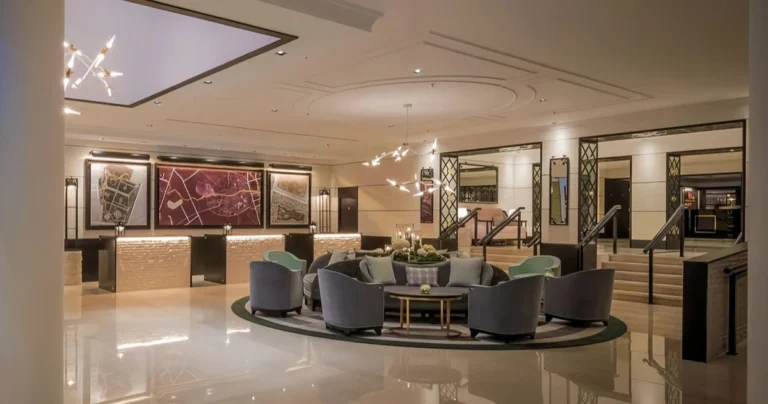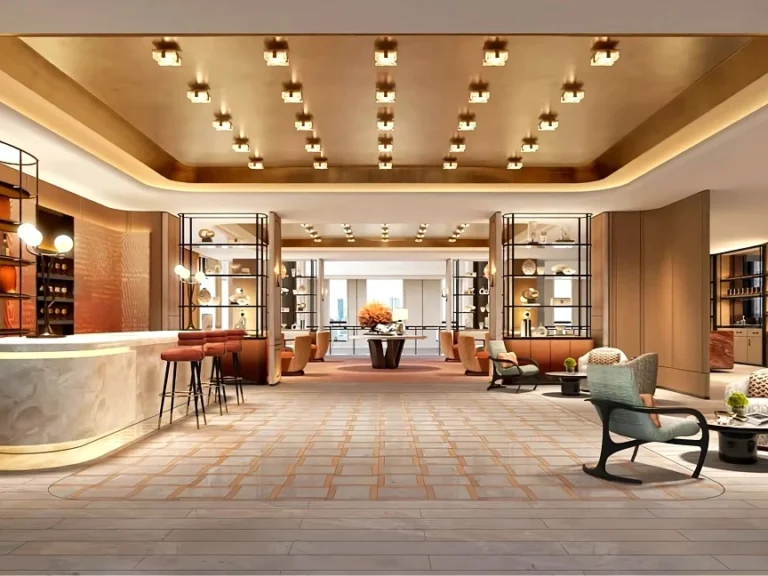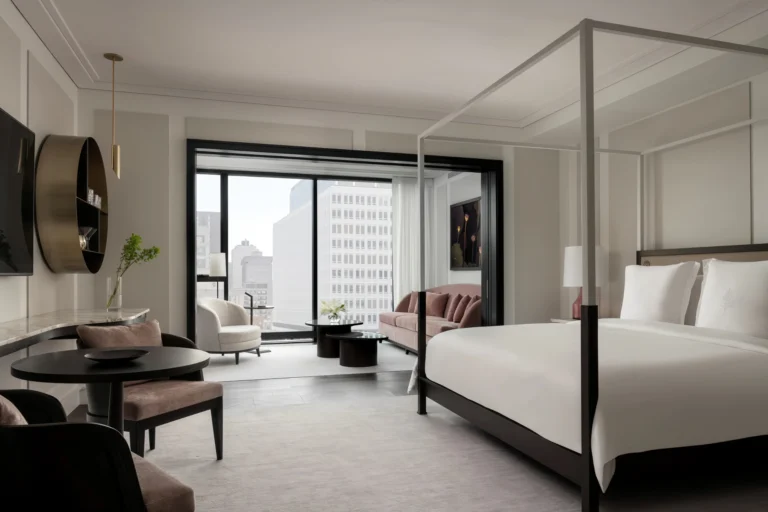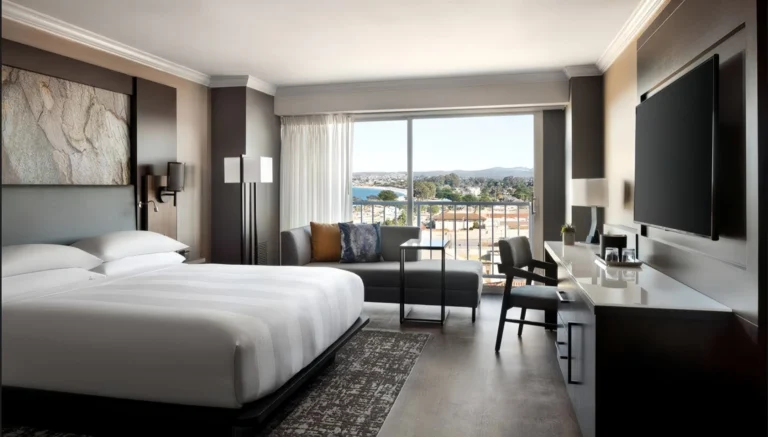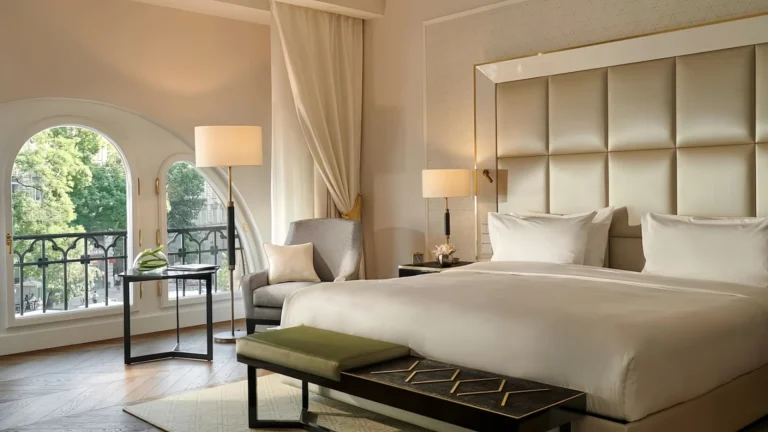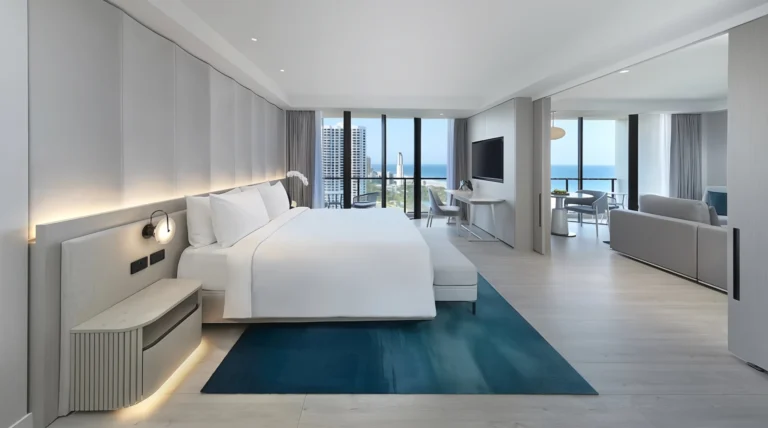What is The Difference of Hotel Funiture Design in 2025
The hospitality industry is entering a new era in 2025, where furniture plays a central role in guest experience and brand identity. Hotel furniture is no longer just about function; it is a statement of comfort, design, sustainability, and innovation. For hotel owners and designers, choosing the right furniture has become one of the most important investments in creating spaces that leave a lasting impression.
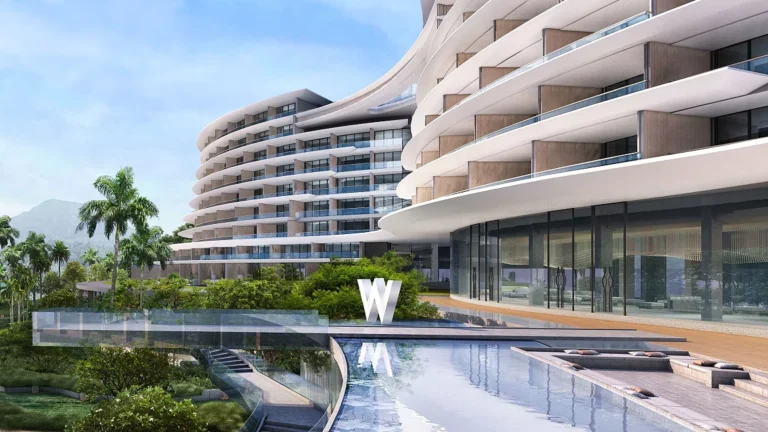
As guest expectations evolve, the demand for hotel furniture design that balances aesthetics, technology, and practicality is higher than ever. From luxury resorts seeking bespoke collections to urban boutique hotels maximizing small spaces, furniture design has become a decisive factor in guest satisfaction and loyalty. Travelers today expect more than a bed and a chair—they want environments that tell a story, reflect local culture, and support wellness and sustainability.
This article explores 10 top trends in hotel furniture design for 2025, highlighting how global design shifts, new materials, and modern lifestyle changes are shaping the future of hospitality interiors. Whether you are a hotel owner, procurement manager, or interior designer, these insights will help you identify what matters most in upcoming projects and how to stay ahead of industry expectations.
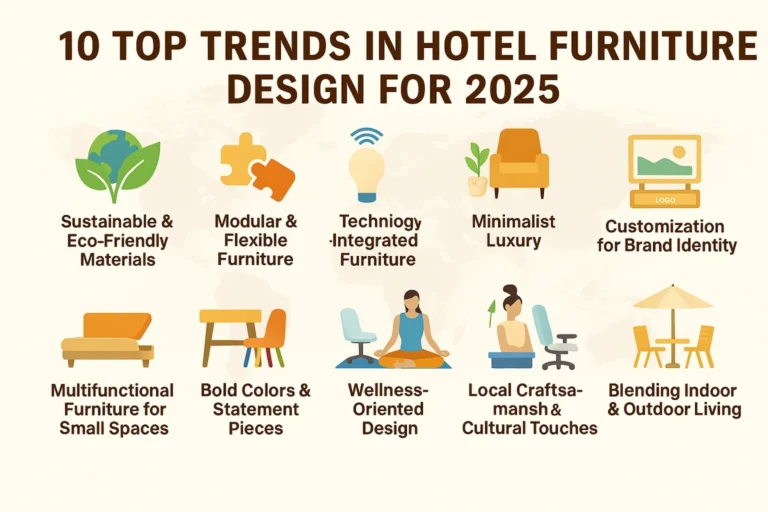
10 Top Trends in Hotel Furniture Design
1. Sustainable & Eco-Friendly Materials
In 2025, sustainability is no longer an option in hotel furniture design—it’s a necessity. Guests are increasingly aware of the environmental impact of their travel choices, and hotels must reflect these values through their interiors. This means selecting furniture made with eco-certified materials, prioritizing durability over disposability, and aligning with global initiatives like carbon reduction and green hospitality. Beyond compliance, sustainable design has become a competitive advantage, as eco-conscious travelers actively seek hotels that balance luxury with responsibility. Modern hotel furniture trends show that green practices can be stylish, sophisticated, and profitable at the same time.
Key Points:
- Responsible Materials – FSC-certified wood, recycled metals, and organic textiles ensure ethical and eco-conscious sourcing.
- Healthier Interiors – Low-VOC adhesives and non-toxic finishes improve air quality and create safer living environments for guests.
- Stylish Sustainability – Eco-friendly furniture now integrates bold design, luxury finishes, and modern aesthetics, proving sustainability can be chic.
- Brand Value & Trust – Hotels adopting sustainable furniture enhance their reputation, attract eco-conscious travelers, and build long-term brand loyalty.
For example, 1Hotels: sustainable luxury hotels & resorts has become a global leader in eco-conscious hospitality. Their properties in New York and Miami showcase reclaimed wood, organic cotton bedding, and furniture made from recycled materials. This commitment to sustainability not only reduces their carbon footprint but also appeals to eco-conscious travelers who prioritize green luxury.
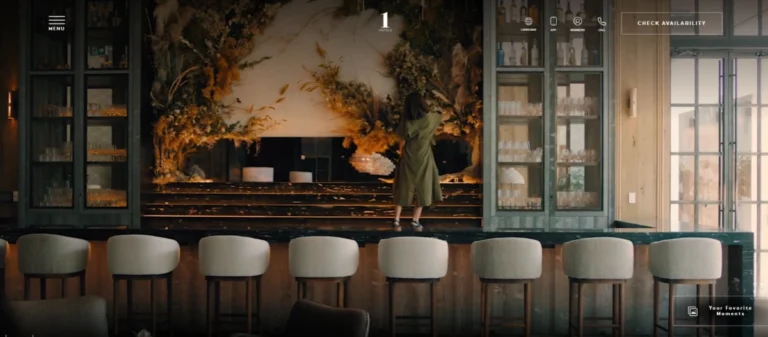
2. Modular & Flexible Furniture
Flexibility has become a cornerstone of modern hotel furniture design in 2025. With the rise of co-working areas, hybrid hospitality spaces, and multi-use guest rooms, hotels can no longer rely on static furniture layouts. Instead, they are investing in modular systems and adaptable pieces that can easily transform a space from day to night, business to leisure, or solo traveler to family stay. This adaptability not only maximizes room functionality but also reduces long-term costs, as hotels can reconfigure existing furniture instead of constantly purchasing new sets. For guests, modular furniture provides a sense of personalization, allowing spaces to feel more tailored to their needs and lifestyle.
Key Points:
- Space Optimization – Modular furniture allows hotels to maximize limited square footage, making even small rooms feel versatile and spacious.
- Multi-Purpose Use – One sofa can become a bed, a desk can extend into a dining table, and partitions can transform open spaces into private zones.
- Cost Efficiency – Instead of frequent refurbishments, hotels can simply reconfigure modular pieces, extending the lifecycle of their investment.
- Guest-Centric Design – Flexible furniture adapts to the needs of business travelers, families, and long-stay guests, improving overall satisfaction.
For example, Boutique Hotels | affordable luxury hotels | citizenM pioneered modular hotel construction, with prefabricated rooms and adaptable furniture that can be assembled quickly. Their compact yet stylish layouts show how modular design makes large-scale expansion efficient while keeping interiors flexible for evolving guest needs.
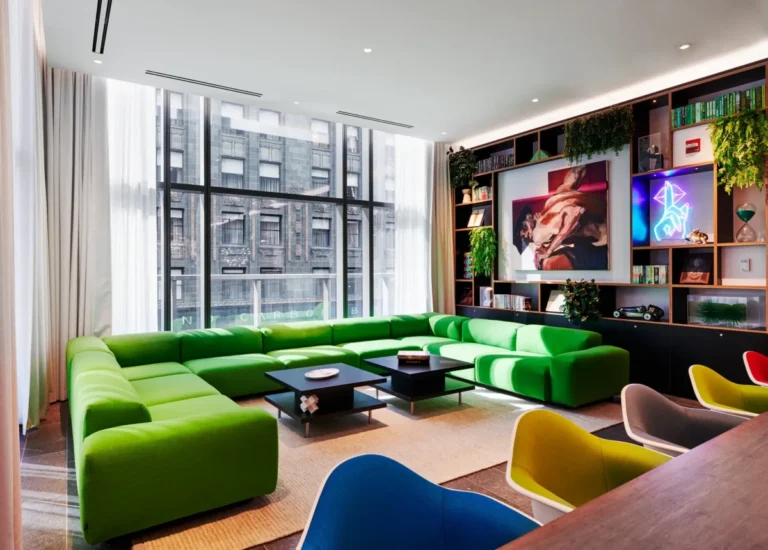
3. Technology-Integrated Furniture
Technology is transforming the hospitality industry, and in 2025 it has firmly entered the world of hotel furniture design. Guests today expect seamless digital convenience, whether they are charging devices, working remotely, or controlling room features with a tap. Hotels are responding by incorporating smart solutions directly into their furniture. From nightstands with wireless charging pads to desks with built-in lighting and power outlets, technology is embedded into design rather than added as an afterthought. This integration not only improves functionality but also elevates the overall guest experience, positioning hotels as forward-thinking and guest-focused. For luxury and business hotels alike, tech-integrated furniture is becoming a standard rather than a luxury.
Key Points:
- Smart Charging Solutions – Desks, nightstands, and side tables with wireless chargers and USB-C outlets meet the needs of modern travelers.
- Built-In Lighting Systems – Smart lamps and LED features enhance ambiance while improving energy efficiency.
- Seamless Workspaces – Furniture designed for remote work includes ergonomic desks and chairs, promoting comfort and productivity.
- Guest Control Integration – Beds, recliners, and lounges equipped with IoT features allow guests to adjust lightin
For example, YOTEL|Book Direct for Exclusive Discounts is renowned for its futuristic cabins, where furniture integrates seamlessly with smart technology. Beds that adjust at the touch of a button, built-in LED lighting, and wireless charging stations create an experience tailored to tech-savvy travelers.
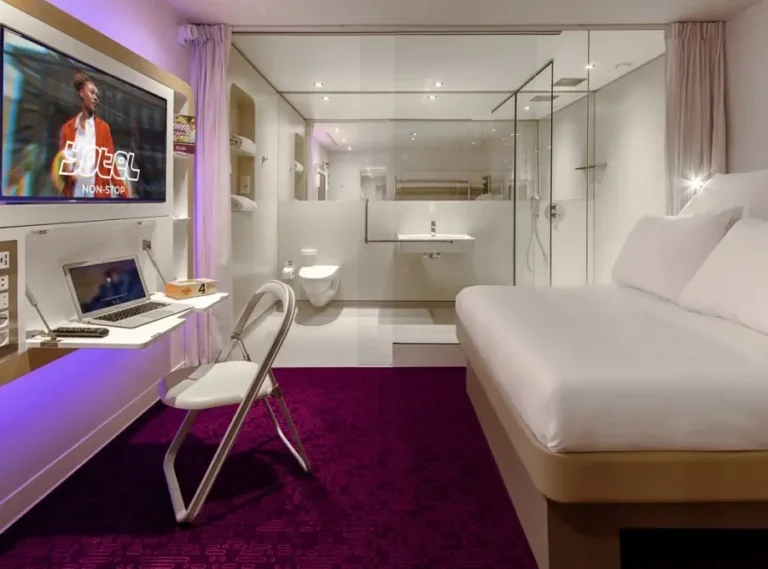
4. Minimalist Luxury
In 2025, minimalist luxury is reshaping hotel furniture design, combining simplicity with sophistication. Today’s travelers seek environments that are uncluttered yet elegant, where clean lines meet premium materials. This design direction reflects a shift from excessive ornamentation to understated beauty, allowing each piece of furniture to serve both function and aesthetics. Materials such as marble, brass, polished wood, and fine leather are used sparingly but with great impact, creating a serene atmosphere that still feels indulgent. For boutique hotels and luxury resorts, minimalist luxury is not only visually appealing but also communicates refinement and timeless style.
Key Points:
- Clean Design Aesthetics – Furniture with sleek silhouettes, neutral palettes, and simple geometries creates calm and visually balanced spaces.
- Premium Materials – High-quality finishes such as marble, leather, and natural wood elevate the minimalist look to a luxurious standard.
- Focus on Functionality – Every item is carefully selected to serve a purpose, eliminating unnecessary clutter while enhancing usability.
- Timeless Appeal – Minimalist luxury ensures that hotel interiors remain stylish and relevant, avoiding quick-to-fade design trends.
For example, Aman Resorts, Hotels & Residences – Explore Luxury Destinations – Explore Luxury Destinations are icons of minimalist luxury worldwide. Their use of clean-lined wood furniture, natural stone, and handcrafted textiles shows how restraint in design can elevate a space, creating calming sanctuaries for discerning guests.
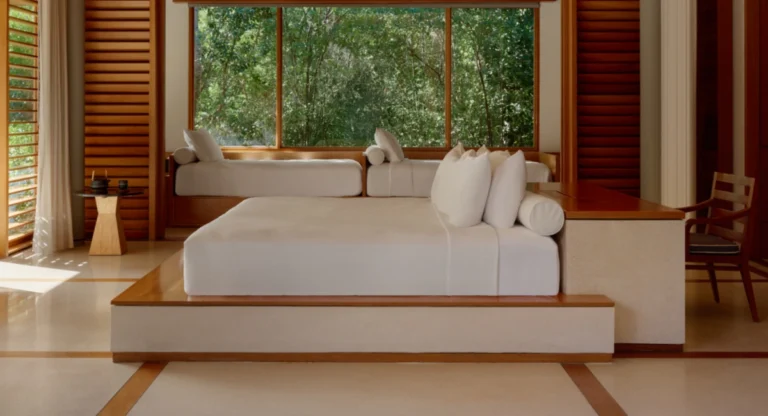
5. Customization for Brand Identity
As competition in hospitality intensifies, hotels in 2025 are placing greater emphasis on customization to reflect their unique brand identities. Standardized furniture is no longer enough; instead, hotels want pieces that communicate their story, values, and aesthetics. Custom hotel furniture allows brands to differentiate themselves and create memorable guest experiences, whether through a signature headboard design, bespoke lobby seating, or furniture that integrates brand colors and motifs. Beyond style, customization also ensures functionality that matches a hotel’s specific operations and space requirements, making it both a branding tool and a practical solution.
Key Points:
- Unique Designs – Custom pieces showcase a hotel’s distinct personality, helping it stand out in a crowded hospitality market.
- Brand Alignment – Furniture can incorporate signature colors, patterns, and finishes that reinforce the brand’s identity.
- Tailored Functionality – Customization ensures that furniture is not only visually aligned but also meets the hotel’s operational needs.
- Enhanced Guest Experience – Personalized details create memorable spaces that guests associate exclusively with the hotel brand.
For example, W Hotels | Luxury Lifestyle Hotels – W Hotels are famous for their bold, highly customized interiors. From neon-colored headboards to sculptural lobby seating, every piece of furniture is designed to reflect both the W brand’s vibrant identity and the local cultural context of each property.
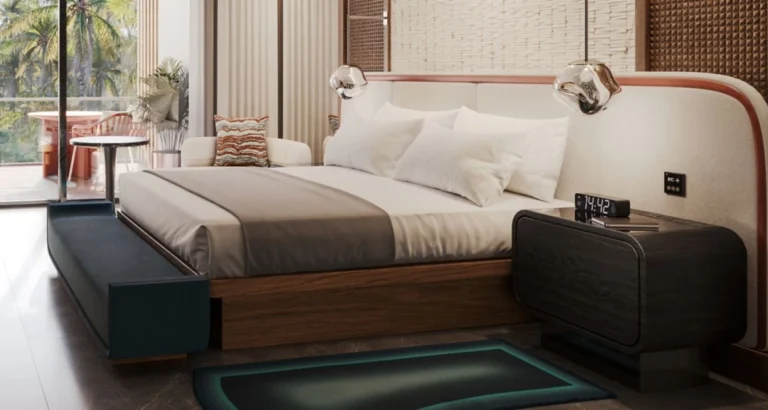
6. Multifunctional Furniture for Small Spaces
With urban hotels and boutique accommodations on the rise, space optimization has become a critical focus in 2025. Multifunctional furniture allows hotels to maximize limited square footage while still delivering comfort and style. From sofa beds and foldable desks to storage-integrated headboards, these solutions provide flexibility without compromising on aesthetics. For city-center hotels, business travel suites, and extended-stay properties, multifunctional furniture is essential to creating environments that feel both efficient and inviting. Guests appreciate the practicality of smart designs, while hoteliers benefit from long-term cost savings and operational efficiency.
Key Points:
- Smart Space Usage – Convertible sofas, murphy beds, and extendable tables help small rooms feel spacious and versatile.
- Hidden Storage Solutions – Furniture with built-in storage, such as ottomans or under-bed compartments, keeps rooms neat and clutter-free.
- Adaptable Guest Experiences – Multifunctional designs allow one room to serve multiple purposes, from working to dining to relaxing.
- Cost-Effective Investment – Hotels reduce the need for additional furniture purchases, maximizing ROI over time.
For example, Stylish & Playful Hotels | Moxy Hotels by Marriott is known for maximizing small spaces with smart furniture. Their fold-down desks, pegboard walls, and under-bed storage units transform compact rooms into playful, functional environments ideal for urban travelers.
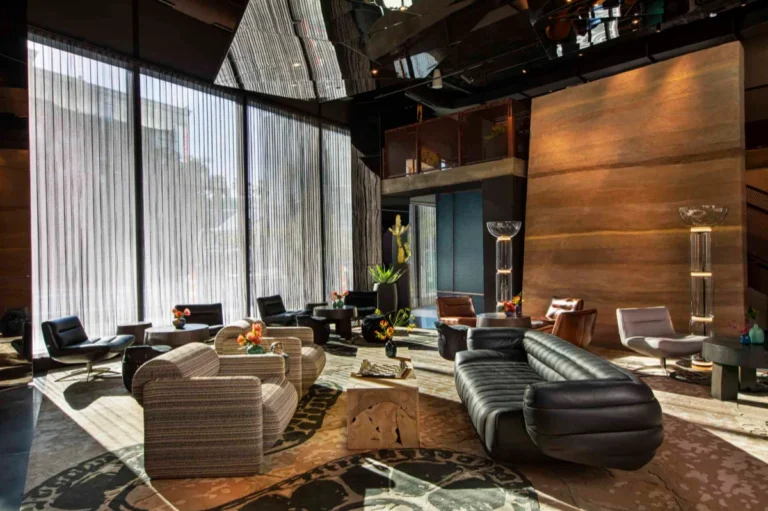
7. Bold Colors & Statement Pieces
While neutral palettes have long dominated hotel interiors, 2025 marks a bold shift toward vibrant colors and standout furniture designs. Hotels are embracing statement pieces that double as functional art, giving guests a reason to remember the space long after their stay. Jewel tones like emerald green, sapphire blue, and ruby red are making appearances in upholstery, while metallic accents and sculptural furniture add drama and elegance. These design choices not only elevate aesthetics but also encourage guests to share their experiences on social media, turning interiors into organic marketing tools.
Key Points:
- Vibrant Color Palettes – Deep jewel tones and rich hues create memorable interiors that break away from standard neutrals.
- Art-Like Furniture – Statement chairs, sculptural tables, or oversized headboards become focal points in lobbies and rooms.
- Social Media Appeal – Bold designs encourage guest engagement on platforms like Instagram, enhancing brand visibility.
- Luxury with Personality – Statement pieces help hotels convey individuality while maintaining a high-end, sophisticated look.
For example, A Modern Cultural Gallery | Modern Luxury | Mondrian Hotels push the boundaries of color and form in their interiors. From oversized, sculptural chairs to jewel-toned lobby sofas, their statement furniture doubles as art installations, creating unforgettable, Instagram-worthy backdrops for guests.
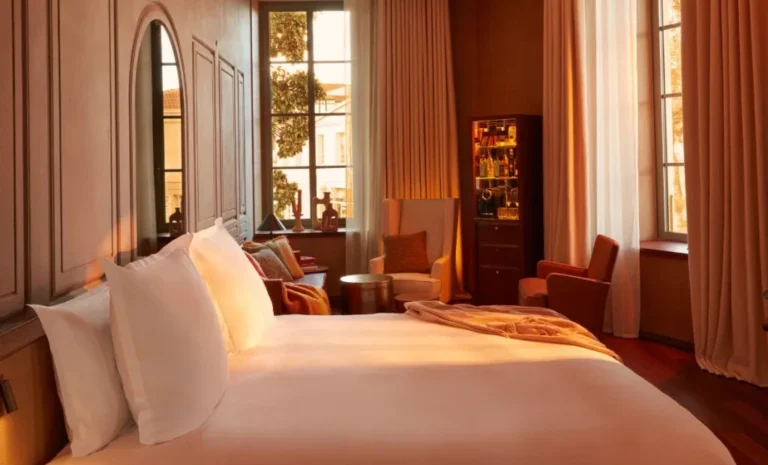
8. Wellness-Oriented Design
Health and wellness have become central to travel in 2025, and hotel furniture design now reflects this shift. Guests are no longer satisfied with just stylish interiors—they expect furniture that promotes relaxation, comfort, and well-being. From ergonomic chairs and posture-friendly desks to beds designed for restorative sleep, hotels are integrating wellness features into every corner of the guest experience. The use of calming colors, natural materials, and biophilic design elements further enhances this trend, creating interiors that support both physical comfort and mental balance.
Key Points:
- Ergonomic Furniture – Chairs, sofas, and workstations designed to support proper posture improve guest comfort and health.
- Sleep-Enhancing Beds – Mattresses with advanced support, sound-absorbing headboards, and ambient lighting create restful environments.
- Natural Materials – Wood, stone, and organic textiles connect guests with nature, reducing stress and enhancing relaxation.
- Biophilic Design Elements – Incorporating greenery and nature-inspired furniture fosters a sense of calm and rejuvenation.
For example, Six Senses Hotels & Resorts integrates wellness into every detail of its resorts. Their ergonomic beds, sustainable wood furniture, and calming design elements are crafted to promote deep rest, while biophilic features ensure guests feel connected to nature during their stay.
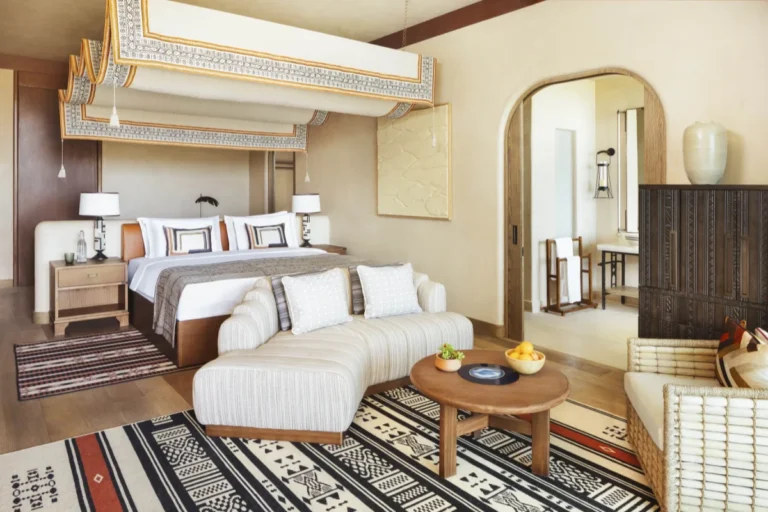
9. Local Craftsmanship & Cultural Touches
In 2025, hotel furniture design is increasingly drawing inspiration from local traditions and artistry. Guests seek authentic experiences that connect them to the destination, and furniture has become a powerful way to tell these cultural stories. Hotels are working with regional artisans to create bespoke pieces that highlight traditional techniques, whether it’s intricate wood carving, handwoven textiles, or region-specific materials. These details not only create a sense of place but also differentiate a hotel from competitors offering generic, globalized designs. For travelers, the integration of local craftsmanship adds depth and authenticity to their stay, turning the furniture itself into part of the destination’s narrative.
Key Points:
- Authentic Storytelling – Furniture design incorporates cultural motifs and traditional craftsmanship, enriching the guest experience.
- Support for Local Communities – Partnering with artisans promotes sustainable development and highlights regional heritage.
- Unique Guest Experiences – Distinctive furniture pieces give hotels a strong sense of place that guests can’t find elsewhere.
- Cultural Luxury – Combining heritage techniques with modern design creates an elevated, one-of-a-kind luxury aesthetic.
For example, Four Seasons Kyoto showcases Japanese artistry through traditional wood joinery, tatami-inspired flooring, and furniture crafted by local artisans. These cultural elements immerse guests in Kyoto’s heritage while delivering modern luxury.
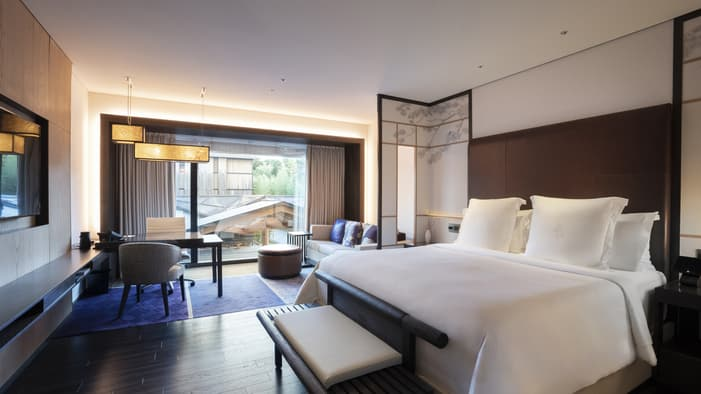
10. Blending Indoor & Outdoor Living
As travelers increasingly prioritize relaxation and connection with nature, hotels in 2025 are embracing designs that blur the boundaries between indoor and outdoor spaces. Furniture plays a crucial role in this shift, with collections designed to withstand the elements while maintaining the same comfort and elegance as indoor pieces. Resorts, boutique hotels, and even urban properties are investing in versatile furniture that creates seamless transitions—from poolside lounges to lobby terraces and private balconies. This approach not only enhances aesthetics but also maximizes usable space, turning outdoor areas into extensions of the guest experience.
Key Points:
- Durable Outdoor Materials – Weather-resistant fabrics, treated wood, and rust-proof metals ensure longevity without sacrificing design.
- Indoor-Style Comfort Outdoors – Plush seating, ergonomic loungers, and stylish dining sets bring the luxury of indoors to open-air spaces.
- Extended Living Spaces – Hotels expand guest experiences by creating functional terraces, rooftop lounges, and patio dining areas.
- Connection to Nature – Indoor-outdoor design fosters relaxation, wellness, and a stronger sense of place within the destination.
For example, Alila Villas Uluwatu in Bali is designed with seamless transitions between indoor and outdoor spaces. Its poolside lounges, open-air dining furniture, and terrace seating create a luxurious, nature-connected guest experience.
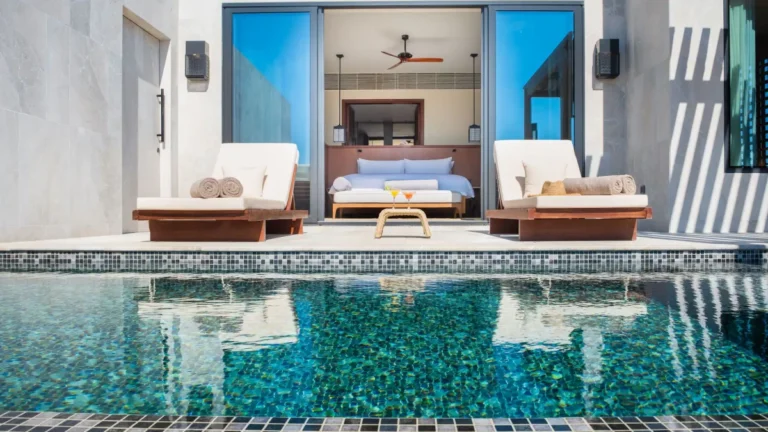
Conclusion: Finding the Best Hotel Furniture Design in 2025
Hotel furniture in 2025 is no longer just about filling a room—it’s about shaping experiences, reinforcing brand identity, and meeting the evolving expectations of modern travelers. From sustainable materials and modular flexibility to wellness-oriented design and indoor-outdoor living, the trends highlighted in this guide show how hotels can stay ahead in an increasingly competitive market. Guests want more than functionality; they want interiors that inspire, comfort, and tell a story.
Hotel furniture in 2025 is no longer just about filling a room—it’s about shaping experiences, reinforcing brand identity, and meeting the evolving expectations of modern travelers. From sustainable materials and modular flexibility to wellness-oriented design and indoor-outdoor living, the trends highlighted in this guide show how hotels can stay ahead in an increasingly competitive market. Guests want more than functionality; they want interiors that inspire, comfort, and tell a story.
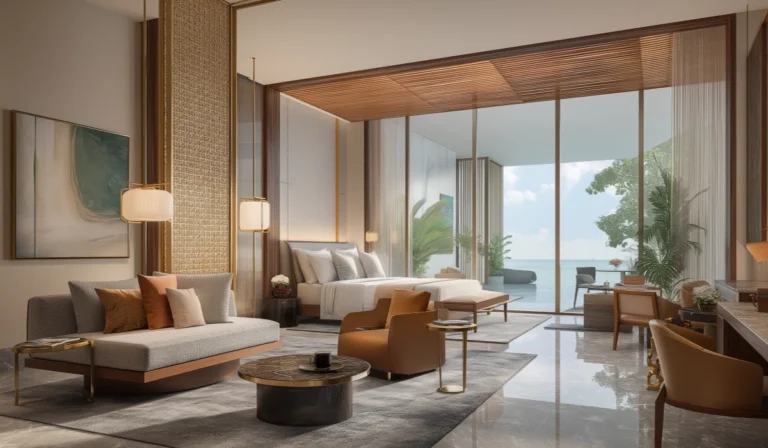
At CenSo Home , we specialize in delivering hotel furniture solutions that bring these global trends to life. With advanced production facilities in China, Indonesia, and Saudi Arabia, over 200,000 m² of fully automated workshops, and a team of 50+ in-house designers, we combine scale with creativity. Our process ensures:
- Precision & Quality – 99.9% pass rate with international standards.
- Customization – Tailored designs that reflect each hotel’s unique brand identity.
- Innovation – Constantly updated collections aligned with the latest hospitality trends.
- Global Reach – Efficient logistics and turnkey delivery worldwide.
By partnering with CenSo Home, hotels don’t just purchase furniture—they invest in long-term value, brand differentiation, and guest satisfaction.

